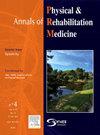Low back pain and disability trajectories in primary care: a growth mixture modeling analysis
IF 4.6
3区 医学
Q1 REHABILITATION
Annals of Physical and Rehabilitation Medicine
Pub Date : 2025-09-26
DOI:10.1016/j.rehab.2025.102023
引用次数: 0
Abstract
Background
People with low back pain are a heterogeneous group with diverse symptoms and recovery patterns, highlighting the need for a better understanding of trajectories toward either rapid resolution or chronicity with persistent disease burden.
Objectives
The aim of this study is to identify clustering of pain and disability trajectories and predictors thereof in adults seeking physical therapy care for low back pain.
Methods
People (n=347) were followed for 12 months in a prospective cohort. Growth classes were identified using growth mixture modeling (GMM) separately for pain and disability. Pseudo-class method was used to calculate the odd ratios between the assigned growth class for pain and disability.
Results
The best-fitting GMM identified two growth classes in both the pain and disability courses. One trajectory with people with moderate pain/disability at first visit that recovered and a second trajectory with people with moderate pain/disability at first visit that did not recover. People in the worst class for disability had higher odds of being the worst class for pain as well (OR 6.8, 95% CI 1.69-9.28). Predictors of class membership for the worst classes in pain and disability were longer duration of complaints (OR 1.24, 95% CI 1.02-1.46) for pain and higher baseline NPRS score (OR 1.31, 95% CI 1.09-1.52) and higher baseline STarT Back Screening Tool (SBST) score (OR 5.49, 95% CI 1.69-9.28).
Conclusion
The odds are high for people in the non-recovery class for disability to also be in the worst recovery class for pain. Longer duration of complaints, higher pain scores, and presence of more psychosocial factors were identified as predictors of slower recovery trajectories. People might benefit from tailored treatment based on these prognostic factors.
Registration
Clinicaltrials.gov 109643; Ethics committee RadboudUMC 2020-6295
初级保健中的腰痛和残疾轨迹:增长混合模型分析
背景腰痛患者是一个异质性群体,具有不同的症状和恢复模式,强调需要更好地了解快速解决或慢性持续疾病负担的轨迹。目的:本研究的目的是确定寻求下腰痛物理治疗护理的成人疼痛和残疾轨迹的聚类及其预测因素。方法对347名前瞻性队列患者进行为期12个月的随访。使用生长混合模型(GMM)分别确定疼痛和残疾的生长类别。采用伪类法计算疼痛和残疾指定生长类之间的奇比。结果最合适的GMM在疼痛和残疾过程中都确定了两个生长类别。一条轨迹是第一次就诊时患有中度疼痛/残疾的人康复了第二条轨迹是第一次就诊时患有中度疼痛/残疾的人没有康复。残疾程度最差的人也有更高的几率成为疼痛程度最差的人(OR 6.8, 95% CI 1.69-9.28)。最严重疼痛和残疾类别成员的预测因子是疼痛的投诉持续时间较长(OR 1.24, 95% CI 1.02-1.46),较高的基线NPRS评分(OR 1.31, 95% CI 1.09-1.52)和较高的基线STarT Back Screening Tool (SBST)评分(OR 5.49, 95% CI 1.69-9.28)。结论残疾患者在疼痛方面处于非康复阶段的概率较高。较长的抱怨持续时间、较高的疼痛评分和更多的社会心理因素被确定为较慢的恢复轨迹的预测因素。人们可能会受益于基于这些预后因素的量身定制的治疗。伦理委员会RadboudUMC 2020-6295
本文章由计算机程序翻译,如有差异,请以英文原文为准。
求助全文
约1分钟内获得全文
求助全文
来源期刊

Annals of Physical and Rehabilitation Medicine
Medicine-Rehabilitation
CiteScore
7.80
自引率
4.30%
发文量
136
审稿时长
34 days
期刊介绍:
Annals of Physical and Rehabilitation Medicine covers all areas of Rehabilitation and Physical Medicine; such as: methods of evaluation of motor, sensory, cognitive and visceral impairments; acute and chronic musculoskeletal disorders and pain; disabilities in adult and children ; processes of rehabilitation in orthopaedic, rhumatological, neurological, cardiovascular, pulmonary and urological diseases.
 求助内容:
求助内容: 应助结果提醒方式:
应助结果提醒方式:


